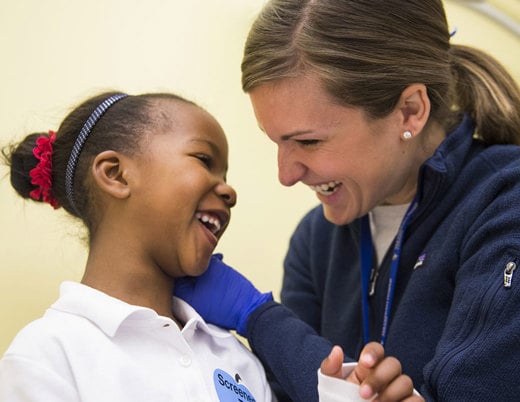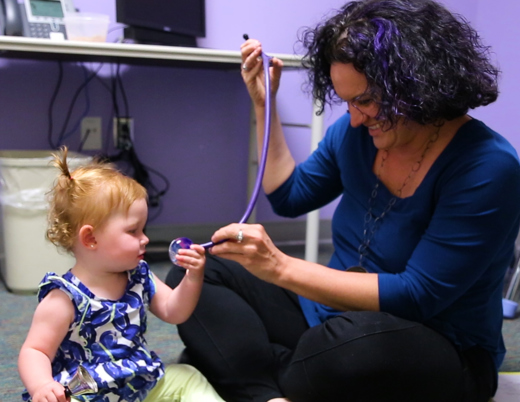How did one patient’s journey with 22q11.2 deletion syndrome inspire a network of care that treats hundreds with this genetic condition?
Up until the age of 4, Melinda “Mindy” Taylor’s daughter Lauren had met all her developmental milestones except one. She had been struggling with speech, and after a few visits to specialists, Taylor learned that her daughter had a submucosal cleft palate. Through genetic testing, doctors diagnosed Lauren with 22q11.2 deletion syndrome, also known as DiGeorge syndrome, which occurs in about one in 4,000 live births and can range from mild enough to overlook, to fatal. The diagnosis was officially made more than two decades ago, but it has continued to impact not just Lauren and Mindy, but kids across the country with this condition.
In children with this genetic disease, a submicroscopic piece of chromosomal material is missing from their 22nd chromosome. This tiny change is responsible for a wide variety of symptoms, including congenital heart defects, hormone abnormalities, kidney anomalies, hearing issues, learning and developmental difficulties, and troubles with speech and swallowing. Given the variety of systems impacted, patients with this condition often require a grueling routine of endless doctor's visits and tests.
“It was a whirlwind. There were multiple things that we needed to check off the enormous list of clinical findings associated with 22q. It was overwhelming for a young mother to handle without a guidebook. No one in our community had heard of 22q. We felt invisible. I was trying to work and cope with the unknowns of a condition that you can't always see just by looking at someone and that no one had heard of. It could take four to five months to get her in to see a single specialist,” Taylor remembers. “It was a barrier to care, honestly.”
Creating the 22q11.2 deletion syndrome clinic
At the time of her daughter’s diagnosis, Taylor was working at Children’s Hospital Colorado in clinical research and was struck by how challenging it was to coordinate specialty care for her daughter. Fueled by her own experiences and the hope of helping others avoid the same hurdles, she spearheaded the start of the Children’s Colorado Chromosome 22q11.2 Deletion Syndrome Specialty Clinic — a team of providers that come together each month to treat children holistically.
Today the Clinic is one of the best in the country for families and kids with this genetic condition. It manages care for nearly 100 patients each year and has a growing list of more than 375 families it serves. Taylor is the program’s coordinator, helping families who are in the same position she once was in herself. She coordinates care by employing the syndrome’s published management guidelines, connecting families to community resources, and providing referrals for therapies and services.
The Clinic is staffed by several core providers from across disciplines that are experts in both 22q11.2 deletion syndrome and their respective fields, including genetics, pediatric cardiology, developmental pediatrics, ENT, speech pathology, audiology and more. The team is committed to caring for these kids throughout their lives, not just while they are young. That means that when patients like Lauren need to visit a new specialist at any point in their care, parents and caregivers don’t have to spend valuable time explaining the diagnosis before treatment can begin.
“Our goal is to be ready to go for our patients so that they can get new access to new therapies, whether that's something that's clinically available or whether it's a research therapy.”
Shawn McCandless, MD
Research to better understand this genetic disease
In addition to providing expert clinical care, the team is dedicated to research that aims to improve treatment and better understand this syndrome's origins.
Much of this work is led by Children’s Colorado geneticists and 22q11.2 deletion syndrome experts Naomi Meeks, MD, and Tamim Shaikh, PhD, with guidance and support from Shawn McCandless, MD. Recent research examined hearing among the Clinic's patient population to get a better sense for trends and patterns of hearing loss. The findings will help providers understand ideal timing for hearing loss screening to optimize interventions. The clinic also recently took part in a clinical trial examining a new treatment that aims to help patients with 22q11.2 deletion deal with neurobehavioral symptoms. Additionally, the team is working with basic science colleagues at the University of Colorado School of Medicine to explore the structure of chromosome 22 more thoroughly in a hunt for clues as to how and why the syndrome occurs.
“We want to make sure that the patients and families are getting their needs met and we're maximizing their care,” Dr. Meeks says.
And according to Dr. McCandless, with such a large patient population, the team is poised to contribute significantly to clinical studies and open new doors to treatment options.
“Our goal is to be ready to go for our patients so that they can get new access to new therapies, whether that's something that's clinically available or whether it's a research therapy,” he says. “We try to make those treatments available to our patients so that they can always count on getting cutting edge care from our clinic.”
Through the Clinic, Children’s Colorado has extended the clinical expertise developed through Lauren’s treatment and care to hundreds of patients and families. Beyond that though, it has created an environment that allows patients and families to heal and thrive.
“Our patients benefit from that,” Taylor says, “and I think they feel like they have a home — they have one place where they can get all of their care, and they have people that listen to them and understand them.”
Featured Researchers

Naomi Meeks, MD
Medical Director, Chromosome 22q11.2 Deletion Syndrome Specialty Clinic
Clinical genetics and genomics
Children’s Hospital Colorado
Associate professor
CU Department/specialty: Pediatrics-Clinical Genetics and Metabolism
CU Institution: University of Colorado School of Medicine

Shawn McCandless, MD
Chair, Department of Genetics and Metabolism
Genetics and Inherited Metabolic Diseases Program
Children's Hospital Colorado
Professor
Pediatrics-Clinical Genetics and Metabolism
University of Colorado School of Medicine





 720-777-0123
720-777-0123










